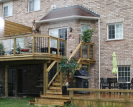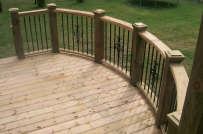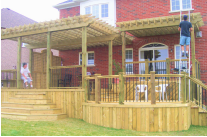The (Original) Fence & Deck Centre.
Just north of Trapper Bob’s Farm, I find my way to the residence and home office of Steve Steinberg, owner of The (Original) Fence & Deck Centre. Although it is a chilly March afternoon and there’s snow still in the bush, there is a hustle and bustle of activity around his parking court. Apparently, a small crew is busy developing a vendor stage set for the Backyard Living Expo in Toronto.
Steve is a “working senior”, which is an inadvertent, recurrent theme in this month’s OTR. I’m sure he has slowed down a bit since the beginnings of the company – because someone teased him about a nap – but I get the impression that he still puts in long days consulting, designing and estimating. It is a lot of work for a closing ratio return of 25-40%. They’ve also started ‘pushing snow’ again in the winter to glide more easily through the off-season.
The Beginnings.
In March 1979, a young man by the name of Geoff, fresh out of Ryerson, got started in a little summer venture he called The Fence Centre. His older brother Steve, while working full time elsewhere and caring for his firstborn (a baby boy named Adam), helped out on a very limited part time basis (he probably watched more than anything). That first year, knowing virtually nothing about building fences, and working out of their parents’ driveway – to the everlasting dismay of their neighbours – the fledgling business still managed to turn a fair dollar, enough to pay for Geoff’s car and a few other luxuries.
Emboldened by modest success, the following spring the brothers went into it full time,
and off they flew. Working out of a rented 12’ x 12’ storage shed in a tiny lumber yard in Richmond Hill, they quadrupled their business. They stuck with building fences, because honestly, that’s all they knew how to do, until July of 1980, when a customer who had just purchased a wood fence from Steve asked if he could build them a deck. Reluctantly, Steve took the job, and Geoff hunted for someone who knew how to do it. Eventually, he found a friend of a friend whose cousin’s uncle was a carpenter from “the old country”. He took on the job, showed the boys what materials were needed and how to build it, and suddenly they were in the deck business. From there, the brothers made it their business to learn how to build decks.
Today’s company can proudly look back on 40 seasons of design and innovation and more than 12,000 installations (you read that correctly). It was the very first deck company in Toronto and is still one of the most respected. Its designs pioneered Toronto’s style, and virtually everybody in the GTA has felt this influence. In fact, more than a dozen current companies, large and small, are owned by installers originally trained at The Fence & Deck Centre.
Eventually, the deck side of the business became so important that the company was renamed “The Fence & Deck Centre”. That’s been their name ever since. The office was located on Langstaff in Thornhill until they moved about 10 years ago to Warden Avenue near Pine Orchard. With Canada Post’s past practices, they and their neighbours were labelled as residents of Newmarket, but now they are rightfully recognized as residents of Whitchurch-Stouffville.
Managing Labour & Quality.
Steve said that managing labour with a seasonal business like this is tough – hiring and laying off people on an annual basis is unnecessarily difficult. Instead, they subcontract jobs to crews, which some people might be uncomfortable with. “It is not like that”, says Steve, “subcontracted doesn’t mean inexperienced. Some of these crews have been with us for 15 years. I pay enough to have high expectations – if they do a poor job, I’ll pull them off in middle of a project and get it right.” Permanently with the company are Steve’s sons Adam, 40, who works in sales, and Noah, 32, who coordinates crews and materials. When a job begins, the Fence & Deck folks have all the materials delivered to the site. They manage as many as 7-8 crews a summer, building about 100 decks or more. Steve says he’s on the road a lot in season doing estimates: “It is an 80-hour work week, no way around it.” Each design takes time, as he may need to design a couple of budgeting options, and then each may need to be priced as wood or composite, with different types of railing details, etc. It goes on and on.
Steve says that there are respectable deck builders out there and less so respectable deck builders. Quality is important: “I’ll build a deck with 12” footings and 16” joists, while others may slide by with a 6” footer and 24” joists. The deck has to be connected into the frame of the house, not just to the veneer,” he said. He buys 10” lag bolts by special order just for attaching decks to houses – these aren’t typically available in box stores.
Steve speaks proudly about an 1,800 square foot deck he built. “It is gorgeous – built out of cedar with an outdoor bar with a stone top. I went overboard with detailing, making the client very happy.” However, he didn’t get fully paid for that job, which he says, unfortunately happens.
Interned in Quebec.
After a couple hours into the interview, Steve relaxes and talks about being born and raised in Toronto. His father was German, and mother was English. Before 1936, his father had been on the German Olympic Swim Team, but things were to change. His father was put in a camp at Buchenwald. Luckily, a relative was able to “buy him out” before the Nazis started killing people in that camp; however, his savior later repaid this act with her life. He escaped to England, where he and other Jews were housed in ‘refugee camps’. They were later loaded onto boats to be shipped to Canada or Australia – as prisoners.
As reported in the Montreal Gazette (30 JE 18), “In a little-known Canadian footnote to the Holocaust… 2,300 Jewish boys and men sent to internment camps in Canada, including six in Quebec, sometimes housed with the very perpetrators of the crimes against them… Fights immediately broke out between the two groups, but the men were quickly separated by the camp guards, mostly Canadian army veterans of the First World War.”
“The only explanation for this about-face on the part of Britain was the sense of panic that had taken hold of London as German troops invaded Belgium, France and Holland. It was feared there might be people acting as spies or people willing to assist Britain’s enemies in the event of an invasion,” continued the article. Jews were interned in Canada for about 3 years until “England stopped sending detainees to Canada and Australia in July 1940, after the Arandora Star, an ocean liner transporting German and Italian internees and POWs was torpedoed by a German U-boat on its way to Newfoundland.”
Steve’s father was later sent back to England. The Allies in England had then decided he was a resource for translating German. He met Steve’s mother in England. “My father was an Engineer, they came to Canada for good in 1949.” The very country that had interned him. Steve concluded the interview with – “My father didn’t talk about those days very much.” With Spring in the air, let the conversation turn back to decks.




